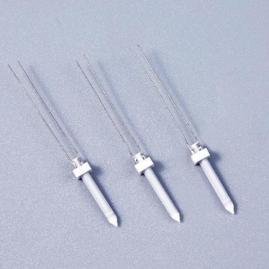Electric Vehicle(EV)

Rate Power:5kW
Peak Power:6kW
Weight:1kg
Communication mode:CAN
Compact size for convenient installation
Lightweight design, 3S heating
Maintain full power within the effective working voltage and temperature range
Thermal efficiency above 98%
Requirements for electric vehicle heating systems
Maintain a constant temperature in the cab
Environmental conditions:
Four passengers
60% fresh air
Fan flow rate:200m³/h
In car temperature:22℃
| Temperature | Required Power Watt |
| -20℃ | 2.69kW |
| -10℃ | 2.03kW |
| 0℃ | 1.39kW |
| 10℃ | 0.71kW |
Front windshield defrosting and cab heating
Environmental conditions:
80% the defrosting rate of the windshield reaches 80% within 20 minutes
Fan flow rate:200m³/h
In car temperature:22℃
| Temperature | Required Power Watt |
| -20℃ | 2.69kW |
| -10℃ | 2.03kW |
| 0℃ | 1.39kW |
| 10℃ | 0.71kW |
Front windshield defrosting and cab heating
Environmental conditions:
80% the defrosting rate of the windshield reaches 80% within 20 minutes
Fan flow rate:200m³/h
In car temperature:22℃
| Temperature | Required Power Watt |
| -20℃ | 4.63kW |
| -10℃ | 3.93kW |
| 0℃ | 3.23kW |
|
No. |
Water-in Temp. |
Water- in Flow Rate |
Voltage |
Current |
Power |
Water- out Temp. |
|
1 |
29.5 |
6L |
220V |
25.18 |
5540 |
42.2 |
|
2 |
29.5 |
8L |
220V |
25.08 |
5518 |
39.1 |
|
3 |
29.5 |
10L |
220V |
25.1 |
5522 |
37.1 |
|
4 |
29.5 |
6L |
220V |
26.2 |
6550 |
43.8 |
|
5 |
29.5 |
8L |
220V |
26.3 |
6575 |
41.6 |
|
6 |
29.5 |
10L |
220V |
26.3 |
6575 |
40.2 |
| 1.2 | Sinusoidal Vibration | CB/T 18488.1-2015 5.6, 4.1
Operation mode: 3,4 (OBC not charged, DC/DC charged) Frequency 10-25Hz, amplitude 1.2mm, frequency 25-500Hz, acceleration 30m/s, sweep rate 1oct/min, each reverse for 8h. Above the amplitude, the acceleration is applicable for "Z" reverse, X, Y reverse divided by 2. During the testing process, environmental temperature changes occur, and the temperature conditions refer to GB/I 28046.1-2011 4.1.1
|
After the test, the IP protection level and insulation performance of each module should not be reduced, and the live parts and casing should not come into contact due to permanent or temporary deformation. After returning to normal, each module in the assembly can work normally under rated conditions | The third Party
|
| 1.3 | Random Vibration | GB/T 28046.3-2011 4,1.2.2.2 | IP protection level and insulation performance of each module should not be reduced, and the live parts and casing should not come into contact due to permanent or temporary deformation. After returning to normal, each module in the assembly can work normally under rated conditions | The third Party
|







